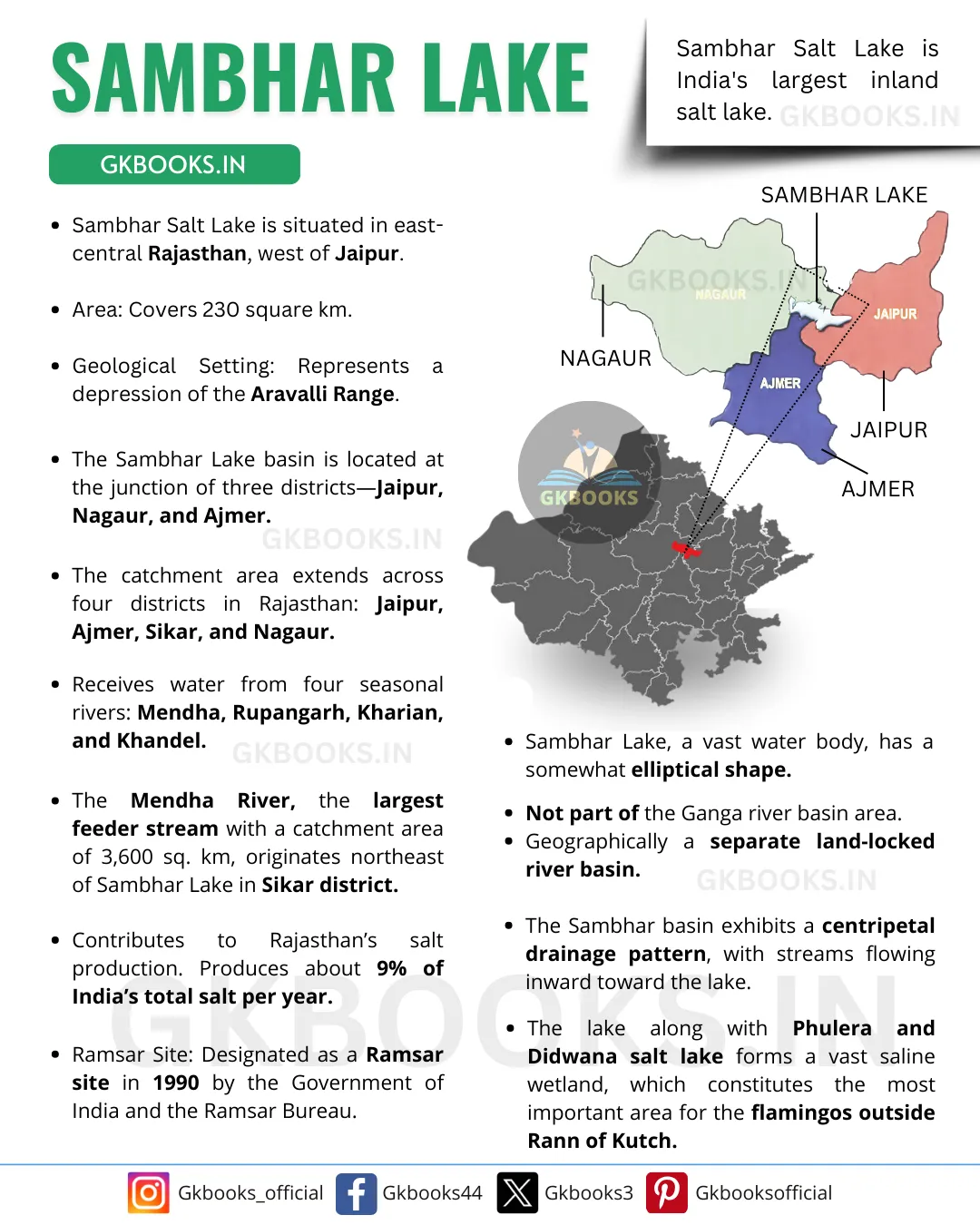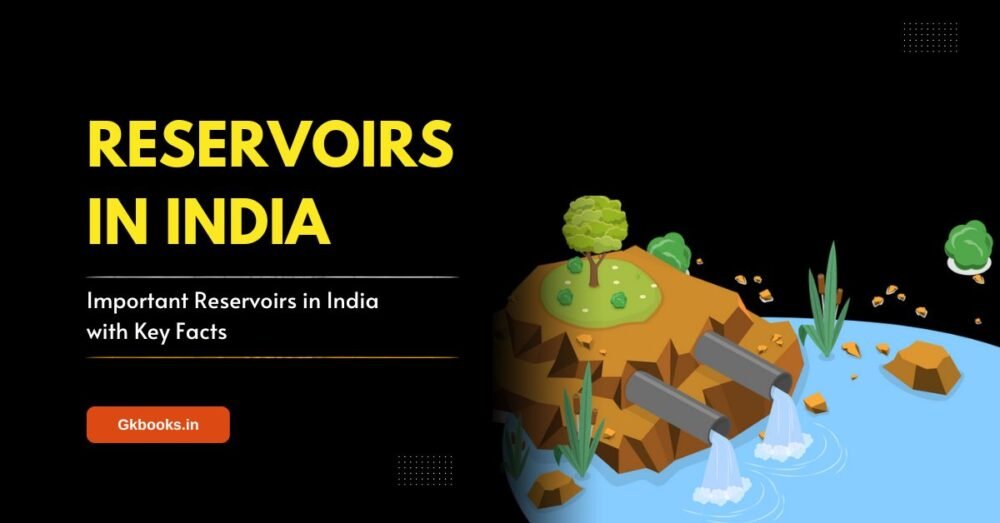Sambhar Lake, also known as Sambhar Salt Lake, is located in Rajasthan and is recognized worldwide for its significance. It was designated as a Ramsar site in March 1990 due to its ecological importance, serving as a crucial wintering ground for thousands of migratory birds, including flamingos, pelicans, and others from northern Asia. Notably, Sambhar Lake is the largest inland saline wetland in India.
✅ Also, Explore: A to Z Important MCQs on Lakes in India
✅ Explore the Complete List of Indian Geography Topics
About Sambhar Lake
- The Government of India recognizes Sambhar Lake as a wetland of international importance and has been designated as a Ramsar Site.
- The vegetation in the surrounding area mainly consists of xerophytic plants, which are adapted to dry conditions.
- The lake basin is spread across three districts of Rajasthan: Jaipur, Nagaur, and Ajmer located near the desert fringe.
- It is bordered by Jaipur district to the south, southeast, and east; Nagaur district to the north and northwest; and Ajmer district to the southwest.
- To the northwest and west of the basin, the Aravalli Ranges rise sharply to over 700 meters, forming hillocks scattered around the lake’s northern and southern edges.
- Sambhar Lake serves as an important habitat for waterbirds, attracting many wetland species during the winter months each year.

For More Latest Maps and Infographics Visit our Official Facebook Page
Physiography of Sambhar Lake
Climate
- Sambhar Lake is located in a transitional climate zone, with arid conditions to the west and a semiarid climate towards the east.
- The climate is influenced by the monsoon season and the region’s topography, particularly the Aravalli range.
- The lake lies on the eastern side of the Aravalli Mountains, which are dissected by wind gaps.
- The area experiences tropical monsoonal weather with three main seasons: summer, monsoon, and winter.
- The average annual rainfall is between 550 to 600 mm, with most rain falling from July to September.
- The average yearly temperature is about 23℃, with winter lows of 8-10℃ and summer highs reaching 40-45℃.
◾Don’t Miss: Top 10 Largest Freshwater Lakes in the World with Facts
Topography of the Lake
- Sambhar Lake has an elliptical shape with a mostly flat lake bed.
- A long stone dam divides the lake into two parts Jhapok in the south and Gudha in the north.
- The western part remains natural and undisturbed, while the eastern part contains two reservoirs, canals, and saltpans used for salt extraction.
Major Soils
- The Sambhar Lake area contains four main types of soil:
- Clay
- Clay loam
- Sandy loam
- Sandy soil
- The general texture of the soil varies from sandy loam to clayey loam, and it is further classified as “Barani” (unirrigated) or “Chahi” (irrigated).
Drainage
- Sambhar Lake is shallow and elliptical, with a catchment area spread across four districts: Jaipur, Ajmer, Sikar, and Nagaur.
- The lake basin features a centripetal drainage pattern, meaning the streams flow inward toward the lake.
- The lake is mainly fed by four primary streams: Mendha, Rupangarh, Kharain, and Khandel, along with small streams from the Aravalli Hills and surface runoff.
Mendha River
- The Mendha River, the largest feeder stream of Sambhar Lake, originates in the northeast of the lake, within the Sikar district.
Protection Status
- Sambhar Lake was designated as a Ramsar site in 1990 due to its ecological significance and the following reasons:
International and National Importance
- Sambhar Lake is renowned for hosting large numbers of flamingos, second only to the Rann of Kutch in India.
- Together with Phulera and Didwana salt lakes, it forms a vast saline wetland crucial for flamingos outside the Rann of Kutch, making it a notable tourist attraction.
- The lake also attracts various waders and migratory ducks, including pochards, coots, and other aquatic birds.
- The catchment area is home to rare and threatened species such as the Uromastix, saw-scaled viper, desert cat, and desert fox.
Changes in Ecological Character
- Major challenges include siltation, soil salinisation, and the discharge of sewage from surrounding towns, which affect the wetland’s health.
Threats to Sambhar Lake
Several issues threaten the wetland ecosystem of Sambhar Lake:
- Landscape Degradation: Loss of agricultural land and groundwater exploitation contribute to the degradation of the landscape.
- Water Management Issues: Indiscriminate water extraction, diversion of surface water inflows, and construction of rainwater harvesting structures disrupt the hydrological patterns and lead to inadequate aquifer recharge.
- Increased Salt-Making Activities: Rising demand for salt has led to more salt-making activities near the lake, causing desertification and impacting the environment.
- Declining Water Levels: Reduced water levels affect the habitat and overall health of the lake.
- Degradation of Waterfowl Habitat: Loss of habitat for waterfowl due to various factors, including pollution and overgrazing.
- Pollution and Waste: Pollution from surrounding towns and villages, along with vehicular transportation, affects water quality.
- Avian Botulism: Outbreaks of avian botulism have led to bird deaths in the marshlands.
- Loss of Lake Area: Approximately 30% of the lake’s area has been lost to mining, illegal salt pan encroachments, and other activities.
- Soil and Water Quality Degradation: Decreased soil and water quality and a decline in the population of migratory birds are ongoing concerns.
Efforts to address these issues are crucial for the conservation of Sambhar Lake and its diverse ecosystem.
Source: Report by Department of Environment and Climate Change, Government of Rajasthan, Jaipur





